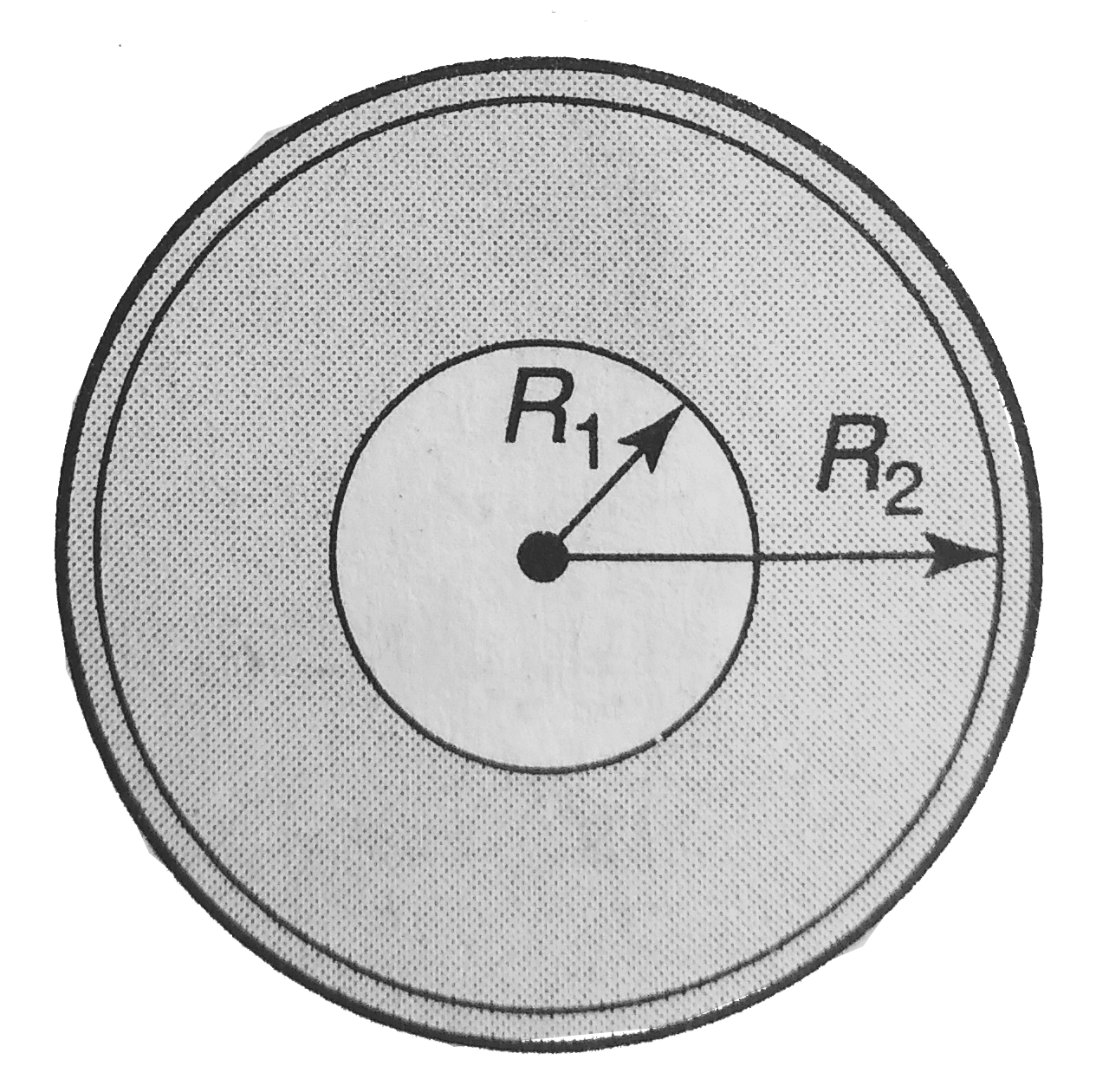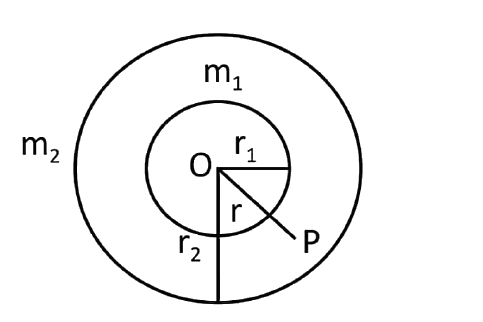Two concentric spherical shells have masses M1,M2 and radii R1,R2(R1<R2). What is the force exerted by this system on a particle of mass m if it is placed at a distance R1+R22 from the center?
The correct Answer is:A, B, D
To solve the problem, we need to determine the gravitational force exerted on a particle of mass m placed at a distance R1+R22 from the center of two concentric spherical shells with masses M1 and M2, and radii R1 and R2 respectively.
1. Identify the Position of the Particle:
The particle is placed at a distance of R1+R22 from the center. Since R1<R2, we know that R1+R22 will lie between R1 and R2.
2. Determine the Region of Influence:
The gravitational force exerted by a spherical shell on a point mass located inside it is zero. Since the particle is located at R1+R22, which is greater than R1 but less than R2, it is inside the outer shell (mass M2) but outside the inner shell (mass M1).
3. Calculate the Force Due to the Inner Shell:
The gravitational force acting on the particle due to the inner shell (mass M1) can be calculated using the formula for gravitational force:
\(
F = \frac{G \cdot M_1 \cdot m}{r^2}
\)
where r is the distance from the center to the particle, which is R1+R22.
4. Substitute the Distance into the Formula:
Substitute r=R1+R22 into the gravitational force equation:
\(
F = \frac{G \cdot M_1 \cdot m}{\left(\frac{R_1 + R_2}{2}\right)^2}
\)
5. Simplify the Expression:
Simplifying the expression gives:
\(
F = \frac{G \cdot M_1 \cdot m}{\frac{(R_1 + R_2)^2}{4}} = \frac{4G \cdot M_1 \cdot m}{(R_1 + R_2)^2}
\)
6. Consider the Outer Shell:
The gravitational force due to the outer shell (mass M2) is zero because the particle is located inside the outer shell.
7. Final Result:
Therefore, the total gravitational force acting on the particle is solely due to the inner shell:
\(
F = \frac{4G \cdot M_1 \cdot m}{(R_1 + R_2)^2}
\)
The particle is placed at a distance of R1+R22 from the center. Since R1<R2, we know that R1+R22 will lie between R1 and R2.
The gravitational force exerted by a spherical shell on a point mass located inside it is zero. Since the particle is located at R1+R22, which is greater than R1 but less than R2, it is inside the outer shell (mass M2) but outside the inner shell (mass M1).
The gravitational force acting on the particle due to the inner shell (mass M1) can be calculated using the formula for gravitational force:
\(
F = \frac{G \cdot M_1 \cdot m}{r^2}
\)
where r is the distance from the center to the particle, which is R1+R22.
Substitute r=R1+R22 into the gravitational force equation:
\(
F = \frac{G \cdot M_1 \cdot m}{\left(\frac{R_1 + R_2}{2}\right)^2}
\)
Simplifying the expression gives:
\(
F = \frac{G \cdot M_1 \cdot m}{\frac{(R_1 + R_2)^2}{4}} = \frac{4G \cdot M_1 \cdot m}{(R_1 + R_2)^2}
\)
The gravitational force due to the outer shell (mass M2) is zero because the particle is located inside the outer shell.
Therefore, the total gravitational force acting on the particle is solely due to the inner shell:
\(
F = \frac{4G \cdot M_1 \cdot m}{(R_1 + R_2)^2}
\)
Topper's Solved these Questions
- BOOK - HC VERMA ENGLISHCHAPTER - GRAVITATIONEXERCISE - Question for short Answers18videos
GRAVITATION
- BOOK - HC VERMA ENGLISHCHAPTER - GRAVITATIONEXERCISE - Objective -26videos
GRAVITATION
- BOOK - HC VERMA ENGLISHCHAPTER - FRICTIONEXERCISE - Questions for short Answer11videos
FRICTION
- BOOK - HC VERMA ENGLISHCHAPTER - HEAT AND TEMPERATUREEXERCISE - Objective 26videos
HEAT AND TEMPERATURE
Similar Questions
Two concentric spherical shells have masses m1, m2 and radit R1,R2(R1<R2). Calculate the force by this system on a particle of mass m, if it is placed at a distance (R1+R2)2 from the centre.
View SolutionTwo concentric spherical shells have masses m1andm2 and radii r1andr2(r2>r1). What is the force exerted by this system on a particle of mass m3. If it is placed at a distance r(r1<r<r2) from the centre ?
View SolutionThe capacitance of two concentric spherical shells of radii R1 and R2(R2>R1) is
View SolutionA sphare of mass M and radiusR2 has a concentric cavity of radius R1 as shown in figure The force F exerted by the sphere on a particle of mass m located at a distance r from the centre of sphere veries as (0≤r≤∞) .
 View Solution
View SolutionTwo concentric spherical shells of masses and radii m1,r1andm2,r2 respectively are as shown. The gravitational field intensity at point P is
 View Solution
View SolutionA spherical shell has inner radius R1, outer radius R2, and mass M, distributed uniformly throughout the shell. The magnitude of the gravitational force exerted on the shell by a point mass particle of mass m, located at a distance d from the center, inside the inner radius, is:
View SolutionTwo concentric shells of masses M1 and M2 are having radii r1 and r2. Which of the following is the correct expression for the gravitational field at a distance r ?
View SolutionTwo concentric shells of masses M1 and M2 are having radii r1 and r2. Which of the following is the correct expression for the gravitational field on a mass m?
 View Solution
View SolutionTwo concentric shells of masses M1 and M2 are having radii r1 and r2. Which of the following is the correct expression for the gravitational field on a mass m?
 View Solution
View SolutionThree spherical shells of masses M, 2M and 3M have radii R, 3R and 4R as shows in figure. Find net potential at point P,
View Solution


